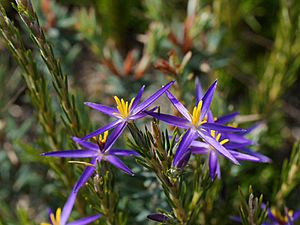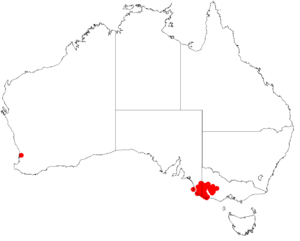Blue tinsel-lily facts for kids
Quick facts for kids Blue tinsel-lily |
|
|---|---|
 |
|
| Calectasia intermedia at Yallakar State Forest, near Edenhope in western Victoria. | |
| Scientific classification | |
| Genus: |
Calectasia
|
| Species: |
intermedia
|
 |
|
| Occurrence data from AVH | |
| Synonyms | |
|
|
Calectasia intermedia, often called the blue tinsel-lily or eastern tinsel lily, is a lovely flowering plant. It belongs to the Dasypogonaceae family. This plant is found only in the border areas of western Victoria and south-eastern South Australia. It is special because it is the only plant in its group (the Calectasia genus) that does not grow only in Western Australia. Its beautiful flowers appear in early spring.
What it Looks Like
Calectasia intermedia is a type of plant that grows from underground stems called rhizomes. It is a perennial herb, meaning it lives for many years. This plant can grow up to about 65 centimeters (25 inches) tall. It often looks like a small bush.
The underground stem (rhizome) is about 50 centimeters (20 inches) long. It is usually buried about 7 to 10 centimeters (3 to 4 inches) deep. The plant's stems have many side branches. Its leaves have only a few hairs. Each leaf is about 5.7 to 16.8 millimeters (0.2 to 0.7 inches) long and 0.5 to 0.8 millimeters (0.02 to 0.03 inches) wide. They get narrower at the end, forming a short, sharp point.
The bottom part of the petals (which are actually called tepals) forms a tube about 10.5 to 11.6 millimeters (0.4 to 0.5 inches) long. The outer parts of the petals spread out. They create a blue, papery, star-like shape. This blue color does not fade as the flower gets older. In the middle of the star, there are six yellow parts called stamens. These stamens form a tube that turns orange-brown over time. A thin part called the style sticks out beyond the stamens. You can see these flowers from September to October.
How it Got its Name
Calectasia intermedia is one of eleven different types of plants in the Calectasia group. A German scientist named Otto Wilhelm Sonder officially described this plant in 1856. He based his description on plants collected by Ferdinand von Mueller. These plants were found in the Grampians in Victoria. The description was published in a science journal.
The second part of the plant's scientific name, intermedia, comes from a Latin word meaning "coming between." This name was chosen because the plant seemed to look like a mix between two other Calectasia species. At that time, these were the only two other species known.
Where it Grows
Calectasia intermedia is found in a few specific areas. It grows from Bordertown in the far south-eastern part of South Australia. This includes the Calectasia Conservation Park. It also grows east into the Grampians and Little Desert in south-western Victoria.
You can find this plant growing in open Eucalyptus woodlands. It prefers sandy soil and areas called heathlands. Its growth areas are spread out, or "sporadic." This is because some of its natural home has been cleared away. However, scientists do not think this plant is currently at risk of disappearing.

